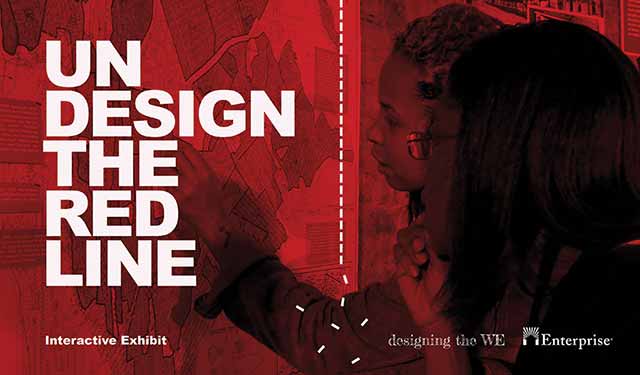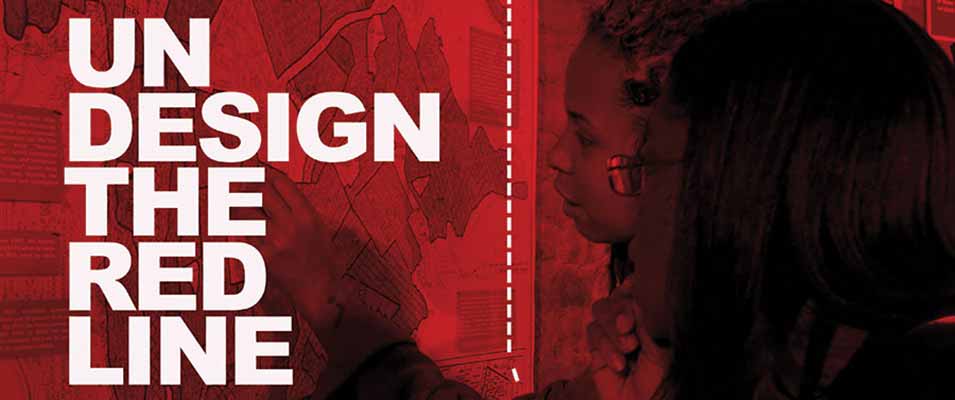
By David Acevedo
On the second floor of the Andrew Freedman Home is a hallway filled with red signs and bold white text. It is home to the “Undesign the Redline” exhibit. Redlining is the practice of not investing in a particular area or neighborhood based on the race of people living within it.
Although the exhibit lacks a room of its own, it is anything but neglected. Its compact size is a testament to how concise and the effective the information it holds truly is, so much so that a short visit provides a good understanding of the problem. It clearly makes the connection between redlining and how it may have affected New Yorkers. It does this through the use of interactive maps of the five boroughs where you can see how your neighborhood is categorized, as well as notes left behind by previous visitors that share their personal experiences with redlining.
The term redlining comes from the process of grading certain areas on a map as worthy or unworthy of investment, which began in the 1930s. Areas were designated by color, depending on its “grade,” which was determined by the ethnicities living in it, the worst one being red. Certain ethnic groups were categorized as white (the Irish, Italians and the Jewish to name a few) and graded higher than other areas in addition to being allowed to buy and own properties in white areas. But the people of color (African Americans and Hispanics) were often denied the freedom to purchase properties in zones with higher grades in order to confine them to zones with high poverty rates.
This was a federal policy and it turned what was once explicit racism into structured racism. This structured racism still remains at large today. Racial wealth gaps, mass incarceration, predatory banking and even an individual’s health are all examples of certain effects redlining left behind. Redlining keeps the poor in areas where they will stay poor and in large groups where it becomes hard for any one person to thrive, while allocating resources to areas where these people either do not reside or do so in incredibly small numbers. New York’s five boroughs were all affected, but there is one that comes to mind that was hit especially hard; The Bronx.
“This really explains the Bronx’s misfortunes.” said Jonathan Espinal, a graphic design student visiting the exhibit. A native of Queens, Espinal had always been under the impression that there wasn’t anything in the Bronx worth visiting. This was because to him, and many other New Yorkers, the Bronx had always been associated with poverty. However, it wasn’t always like this. The Bronx was once a place of great commerce. The economic decline the Bronx suffered from was due in part to disinvestment and redlining by both the federal government and wealthy investors. As the Bronx became more and more racially diverse, it fell victim to “white flight,” a term used for the sudden migration of white residents of an area to escape diversity.
“I prefer to live in a diverse neighborhood,” said Beth Venn, Deputy Director of the Andrew Freedman Home and current resident of the Bronx. Venn does not believe she was directly affected by redlining due in part to being white but she believes that it has indirectly affected her. Redlining segregated neighborhoods and, because of that, it has limited the amount of diverse communities in New York. “I found it shocking that redlining was about more than just mortgages,” said Venn when asked if anything in the exhibit initially came as a shock. “The exhibit itself is very important and was very enlightening.”
As the name entails, the creators of the traveling exhibit offer a solution, a way to undesign the redline. They suggest reframing the misinformation redlining propagated and not allowing New Yorkers to be valued by where they live or what ethnicity they are. By redesigning how the community collaborates, they say, New Yorkers can set up a reinvestment process that will target education, housing and communities in order to create a shared value. The diagram for this solution at the exhibit reads: “Ecosystem Building Is The Opposite Of Redlining.”
Source: UNDESIGN THE REDLINE



